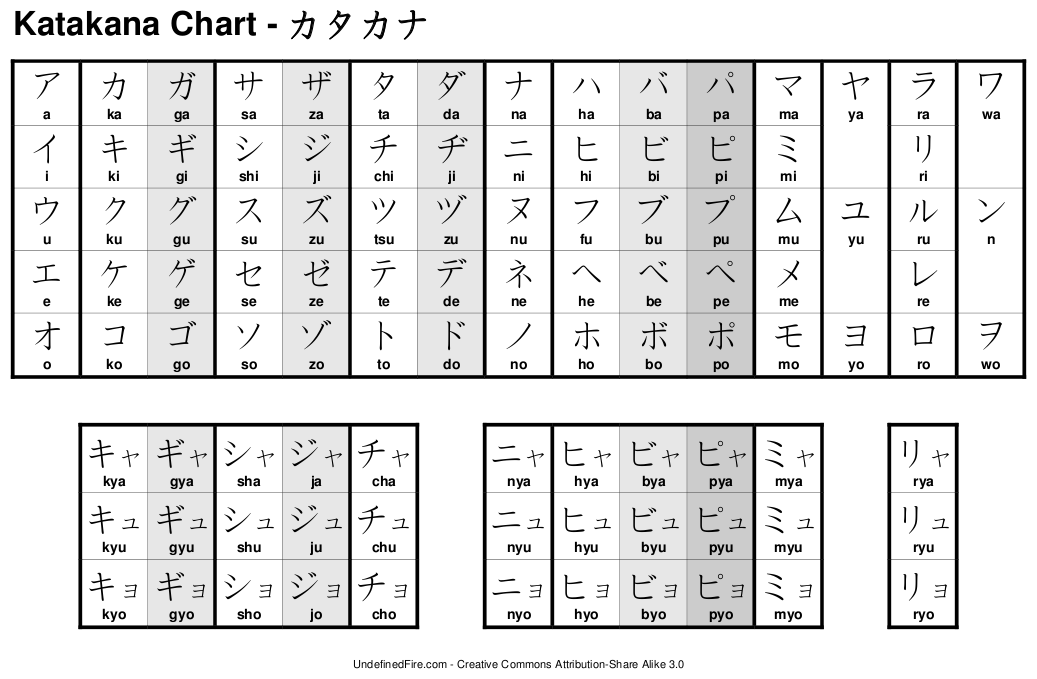Well…it’s been 十四日 since our last lesson…
I hope all of you are still studying your kanji every 日! (Quitters never prosper)
Today, we will be exploring the world of Hiragana and Katakana!
Both are Japanese syllabic alphabets, but each is used for different words or situations.
(Side note: both alphabets together are referred to as “Kana”)
Hiragana is the traditional Japanese alphabet. It is used for standard Japanese words, adjectives, and verb endings. Katakana is a different set of characters that represent the same syllables as hiragana, but they are used for words of foreign origin that have found their way into the Japanese language (words such as milk, orange, television, etc).
You may have heard a character in an anime say a word that you very nearly recognize as an English word, but it sounds slightly different. This would be a typically be an “imported word” and would be written in Katakana.
“But Cubesy, why on earth have two alphabets?! That’s just plain silly!”
Not really. Just think about it for a minute. You ALREADY know two alphabets.
You had to learn capital AND lowercase letters in English, right?
Just like with capital/lowercase letters, hiragana/katakana are used in different contexts and situations. Some of them even resemble each other!
Enough chit-chat, let’s dive into it!
Hiragana:

Katakana:

Print off a few hundred copies of those diagrams. Keep one in the car, one by the computer, one on the refrigerator, one in the sock drawer, one on the cat…
They are relatively easy to learn (MUCH more so than Kanji). If you’d like, you can even download premade decks for Anki to help you study! (Just scroll down to “Japanese” and download the kana deck of your choice)
Click me
A few things to take note of:
1) Keep in mind that the “vowel” sounds are pronounced:
A = “ah”
I = “ee”
U = “oo”
E = “eh”
O = “oh”
For instance, the color red is “あかい” and is pronounced “ah-kah-ee”
The imported word for sweater is “セエタ” and is pronounced “seh-eh-tah”
The list goes on…
2) As stated in the last lesson, the Japanese version of “r” isn’t pronounced the same as it is in English. Their “r” is more of a cross between a “d” and an “l”. If you listen closely to the dialog of your favorite anime, you can pick up on how this sounds.
3) Just as it is with any language, there are SOME exceptions to pronunciations. (Though not NEARLY as many as there are in English) For example, the Hiragana “は” (ha) can also be pronounced as “wah”, depending on it’s context. These rules are hard to explain, but will be understood later on down the road when you start studying sentences.
Good luck!
Keep on studying that Kanji and Kana,
and until next time…
さようなら! (Sayounara)
-Cubensis

“Well…it’s been 十四日 since our last lesson…”
It should be ‘十四日間’.
“I hope all of you are still studying your kanji every 日!”
Every day is ‘毎日’.
“the colour red”
The noun for red is ‘赤’ (‘aka’). The adjective is ‘赤い’ (‘akai’). Can also be stated as ‘赤の’ (‘aka no’).
“As stated in the last lesson, the Japanese version of “r” isn’t pronounced the same as it is in English. Their “r” is more of a cross between a “d” and an “l”.”
Uhh… what?
“For example, the Hiragana “は” (ha) can also be pronounced as “wah”, depending on it’s context.”
Now how about the other 2?
I’m trying to keep things as simple and easy to understand as possible, psy.
The kanji I used are in the first 12 (using the heisig method) so most people should know them if they’ve studied at all.
As for the “r” sound… Well… I can’t explain it better than that. 🙂
Just trying to keep things simple…
Keeping it simple is one thing, but leaving gaps in people’s knowledge is another.
I get that there is Hiragana and Katakana. but when ever I visit a Japanese web site I get this 十四日 that looks like some form of Hexadecimal encoding. What is that 十四日 and how do you read it. In video games and books you never see Japanese like 十四日 but on the web there it is.